|
  |
|
Page 8 |
Newsletter 123, WInter 2018 © Hampshire Mills Group |
|
The Black Gold of Cyprus
Ruth Andrews
Pictures by Keith and Ruth Andrews
|
 |

|
|
“Until
the end of the colonial era, and before the advent
of modern agriculture with its large scale irrigated
crops like potatoes and citrus fruits, carobs were
among Cyprus’s main agricultural export products.”
Typical annual production was approximately 50,000
tons from 2 million trees. Trade was transformed in
1911 when steamships were loaded with carobs for
export to England. As a result N P Lanitis Ltd in
Limassol (Lemesos), established in 1896, became the
island’s largest exporter.
|
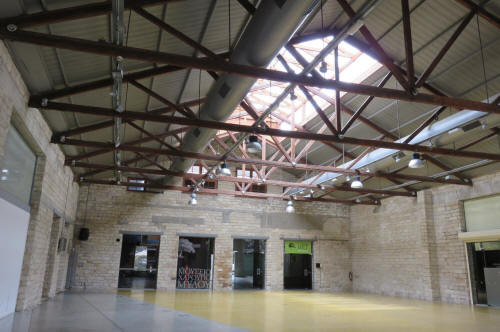 |
Their warehouses have now been revived as a meeting
and dining venue, and the machinery has been
retained as a museum. Keith and I came upon it when
we were trying to decide where to go for lunch. As
usual in these situations there was no leaflet to
take away, but the wall panels gave a good
explanation so we photographed them; this article
is the result. |
Dried carobs arriving from the fields, where they had been
knocked off the trees with sticks, were weighed and
size-sorted. “Foreign bodies, such as pieces of wood, or
stones, that all but accidentally had sneaked into the
farmers’ delivery bags were discarded amidst commonplace
quarrelling and practical joking.” Large pods were set
aside for export intact, but the rest were kibbled, crushed,
and sieved. There were 3 final products: small carob
cubes, carob flour, and seed.
The mill machinery used in this process bears a striking
resemblance to the sort of set up that we would expect to
find in a flour roller mill at home, and was just as
difficult to photograph meaningfully. The grinding and
separation process is shown in the following flow diagram,
followed by some pictures of the machinery. I have copied
the explanatory text intact. although I have corrected and
enlarged the labels. I hope you can follow it.
|
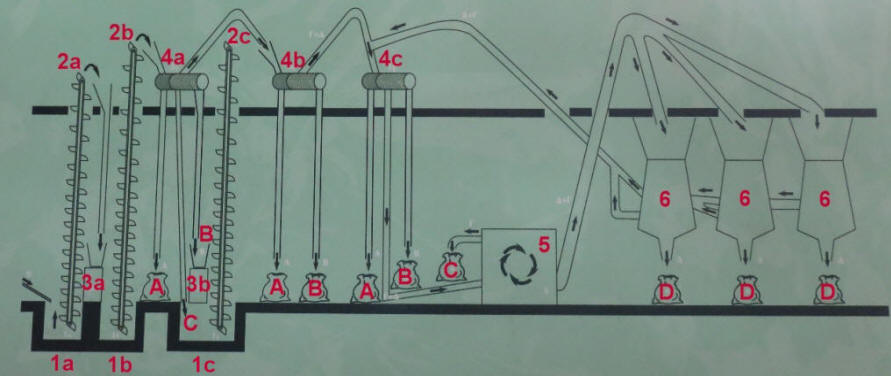
The carobs fall into the first pit 1a where an
elevator 2a scoops them up and feeds them into the
first crusher 3a. The broken-up carobs are scooped
from a second pit 1b by another elevator 2b that
feeds them into a first cylindrical separator 4a
which produces carob meal A gathered into sacks,
medium C, and cube B. The cube is fed into the
second crusher (3b) to be crushed into smaller
pieces which are subsequently mixed in a pit 1c with
the medium.
A third elevator 2c feeds the mixture into the
second cylindrical separator 4b out of which comes
carob meal A and cube B which are gathered into
sacks, and seeds mixed with medium, which are sent
to the third cylindrical separator 4c.
This again gives carob meal A and cube B which are
gathered into sacks, and seeds mixed with medium.
These are fed into the large separator 5 where the
medium C, which is lighter, is whirled up by air to
be sent via a duct into sacks, whereas the seeds D
are fed into the final separator 6 to be completely
cleaned from any residue. From there the seeds D
are gathered into sacks, but a small quantity still
mixed with medium is taken back to the third
cylindrical separator 4c to be reprocessed.
|
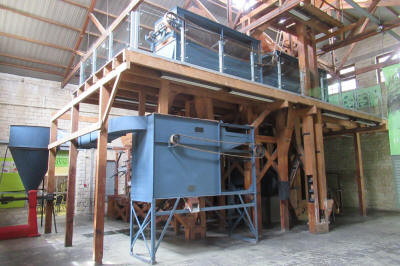 |
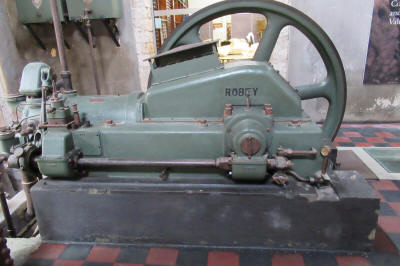 |
 |
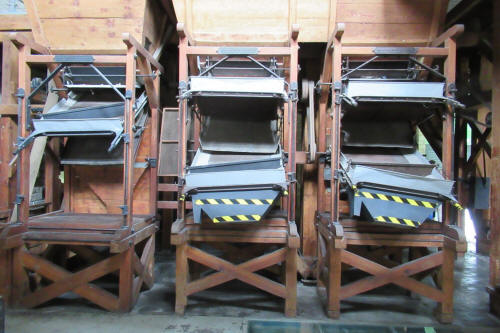 |
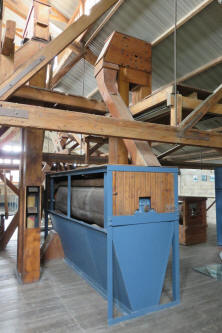 |
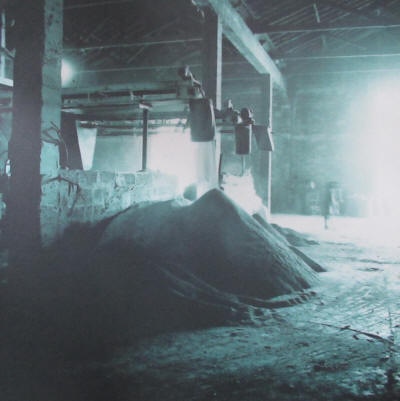 |
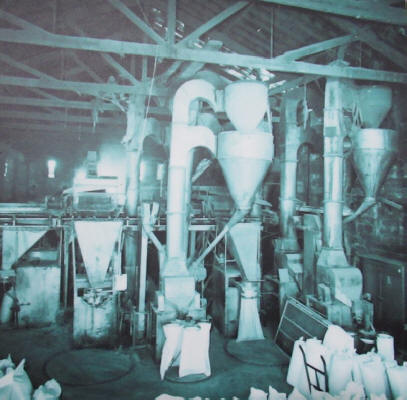 |
|
These pictures from the wall display probably give a
more accurate idea of what the mill was like.
Quoting again: “The most important use of carobs
was, and still is, the enrichment of livestock
feed. For this purpose. carobs are consumed whole
or cracked (cubed) after they are kibbled, that is
after the seed is removed. The seed itself is
shelled and the embryo is separated from the
endosperm. A natural gum is extracted from the
endosperm. It is used in the food industry, in
cosmetics, in paper manufacturing, making
photographic film, and dyeing. In World War 2 it
was used in the manufacture of parachutes.”
Carob flour and syrup are used as replacements for
cocoa, coffee, and sugar, in chocolates and
biscuits. The flour has low fat content, high
natural sugar, and high levels of minerals and
vitamins. In addition to the pod, carob tree bark
and leaves contain tannin which was used for dyeing,
particularly sails.
Finally, the seeds of the carob, due to their
roughly consistent individual weight, were used –
initially in ancient Egypt – as a measure of weight
for gold. The term ‘carat’ most likely derives from
this.
|
  |
|
|
